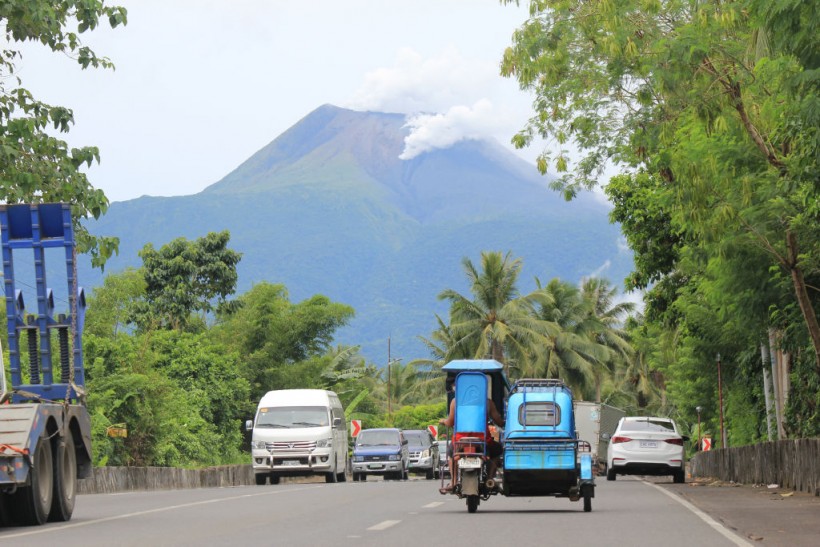Mount Bulusan in the province of Sorsogon, Philippines, spewed ash and steam during an "ongoing phreatic eruption" on the morning of Sunday, June 5, according to local authorities.
Multiple media reports and social media posts suggestrd the that some rural residents have been alarmed amid fears of a looming major volcanic eruption.
The authorities raised the status to Alert Level 1, which poses a minor yet potential threat communities in the area.
There were no immediate reports of large-scale, mandatory evacuations, as well as any casualties.
Officials are still monitoring the situation as a possible eruption may occur with little or no warning.
Phreatic Eruption

In a Twitter post on Sunday, the Philippine Institute of Volcanology and Seismology (PHIVOLCS) announced the Alert Level 1 status over the Bulusan Volcano as a means to warn the public and concerned authorities.
This is to notify the public and concerned authorities of an ongoing phreatic eruption at Bulusan Volcano. Details to follow.
— PHIVOLCS-DOST (@phivolcs_dost) June 5, 2022
The status is part of the Philippine agency's five-tier scale; with Alert Level 0 being the lowest and Alert Level 5 being the highest.
A level 5 is marked by a life-threatening eruption to nearby communities due to volcanic hazards, such as widespread ashfall, lethal pyroclastic flows, lava emission, volcanic earthquakes, and magmatic eruption.
The Philippine Institute of Volcanology and Seismology (PHIVOLCS) explaine the current status level means it is in a state of an abnormal condition.
Relative to its calm state before Sunday, the Bicol Region's stratovolcano has showed signs of increased volcanic activity.
The phreatic eruption occurred approximately at 10:37 a.m. PHT (local time) and lasted around 17 minutes, releasing a plume of ash into the air of at least 1 kilometer.
The grey plume was observed from a nearby municipality of the province, according to PHIVOLCS, as cited by local newspaper Philippine Daily Inquirer.
Also Read: Indonesia's Mount Ili Lewotolok Erupts, Thousands of People Evacuated
Volcanic Ashfall
There were 14 people with four tour guides hiking on the side of the volcano when the phreatic eruption occurred.
Still, all of them were able to seek refuge in a nearby town safely, according to the Associated Press.
The Associated Press also confirmed, through telephone, a statement from a local named Rica Tomale who was hanging her laundry when volcanic ashfall started pouring in the coastal town of Juban, near Bulusan where the volcano is located.
The villager also reportedly stated two motorcycles slipped since the road was covered with ash.
The drivers remained unhurt.
The towns of Casiguran and Irosin in the province were also affected by the ashfall. I
n addition, authorities reported the villages of Anog, Bacolod, Buraburan, Sangkayon, Catanusan, and Guruyan also experienced light to heavy ashfall, as cited by the Philippine Daily Inquirer.
Volcanic Earthquakes
Over the past 24 hours prior to the phreatic eruption, PHIVOLCS recorded 77 volcanic earthquakes.
The said eruption at Mount Bulusan occurred due to various factors, including volcanic water heating or new volcanic deposits indirectly caused by hot rocks or magma, according to PHIVOLCS Director Renato Solidum who told CNN Philippines.
A similar phreatic eruption occurred at Bulusan Volcano in December 2016, emitting a volcanic ash plume of up to 300 meters or nearly 2 kilometers high.
The Philippines is situated along the so-called "Pacific Ring of Fire," a region in the Pacific Ocean where seismic activities, volcanic eruptions, and earthquakes are common due to the movement of underground tectonic plates.
Related Article: Scientists Linked a Powerful Volcanic Eruption in 2020 to Prolonged Thunderstorm
© 2024 NatureWorldNews.com All rights reserved. Do not reproduce without permission.

![Tsunami Hazard Zones: New US Map Shows Places at Risk of Flooding and Tsunamis Amid Rising Sea Levels [NOAA]](https://1471793142.rsc.cdn77.org/data/thumbs/full/70325/280/157/50/40/tsunami-hazard-zones-new-us-map-shows-places-at-risk-of-flooding-and-tsunamis-amid-rising-sea-levels-noaa.jpg)



